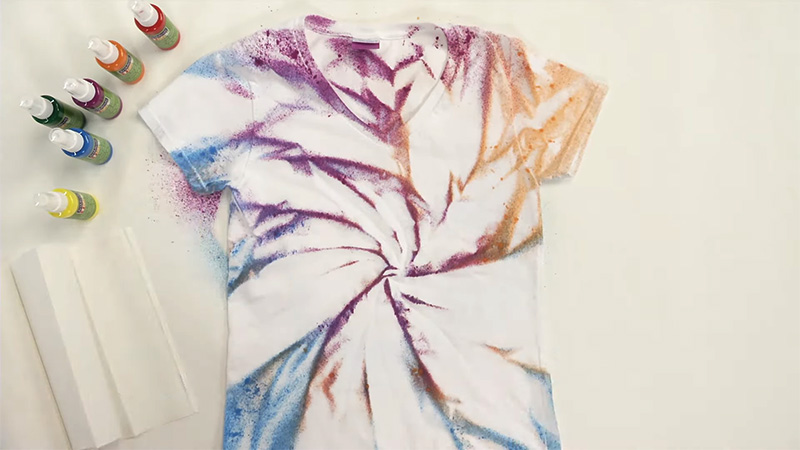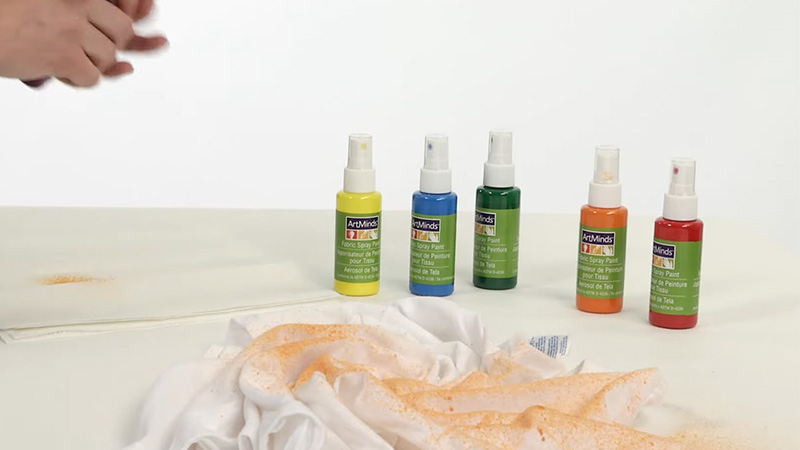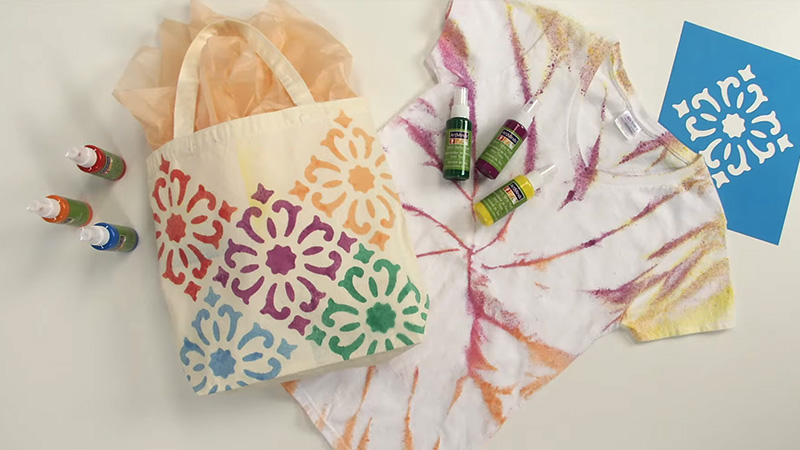Spray painting nylon fabric is a captivating and versatile creative venture that allows you to infuse vibrant color and personalized designs into your everyday items.
Whether you seek to revamp a tired backpack, add a unique touch to your outdoor gear, or simply unleash your artistic flair, the answer is clear: yes, you can spray paint nylon fabric.
This guide delves into the exciting world of nylon fabric transformation, offering step-by-step instructions and essential tips to ensure your artistic endeavors on this resilient material yield outstanding, long-lasting results.
Explore the possibilities, from fashioning one-of-a-kind apparel to breathing new life into household essentials, and discover how this innovative DIY technique can elevate your style and self-expression.

Can You Spray Paint Nylon Fabric?
Yes, you can spray paint nylon fabric. Spray painting nylon fabric is a creative way to add color and designs to clothing, accessories, and various fabric items.
Here are the basic steps to spray paint nylon fabric:
Materials You’ll Need
- Acrylic Paint: Acrylic paint is a suitable choice for fabric painting, including nylon. It offers a wide range of colors and is readily available.
- Fabric Medium: Mixing acrylic paint with fabric medium is crucial for fabric painting. Fabric medium enhances paint adhesion, flexibility, and durability on fabric, preventing cracking or peeling. Follow the manufacturer’s instructions for the correct mixing ratio.
- Spray Bottle: You’ll need a spray bottle capable of producing a fine mist of paint. You can purchase one designed for painting or repurpose a clean spray bottle.
- Nylon Fabric: Ensure the fabric is clean and free from any dirt, dust, or oils. It’s advisable to wash and thoroughly dry the fabric before starting your project.
- Protective Covering: Cover your work area with newspaper, cardboard, or plastic to protect it from overspray and make cleanup easier.
Steps to Spray Paint Nylon Fabric:
Prepare the Fabric
Start by washing and thoroughly drying the nylon fabric you plan to paint. This step removes impurities and ensures that the paint adheres well. Ensure the fabric is entirely dry before proceeding.
Mix Paint With Fabric Medium
In a separate container, mix the acrylic paint with fabric medium, following the manufacturer’s instructions. Typically, a 1:1 ratio of paint to fabric medium is recommended.
Stir the mixture thoroughly for even distribution.
Load the Spray Bottle
Fill your spray bottle with the diluted paint mixture. Make sure the paint is appropriately thinned to avoid clogs in the spray nozzle.
Test Spray
Before applying the paint to your fabric, conduct a test spray on a scrap piece of fabric or paper. This allows you to check the spray pattern and make any necessary adjustments to the nozzle.
Spray the Fabric
Hold the spray bottle about 6 inches away from the fabric’s surface. Begin applying the paint in short, controlled bursts, ensuring even coverage. Avoid over-saturating the fabric to prevent drips or runs.
Maintain a steady, consistent motion for a uniform finish.
Create Designs (Optional)
If you want to add specific patterns or designs, consider using masking tape or stencils to mask off areas before spraying. This adds a creative touch to your fabric.
Drying
Allow the first coat of paint to dry for about an hour. If you want to expedite the drying process, a hairdryer set to a low or cool setting can help.
Proper drying ensures good paint adhesion.
Additional Coats (if Needed)
Depending on your desired color intensity and coverage, you may choose to apply additional coats of paint. Ensure each coat is fully dry before applying the next, maintaining the same consistent technique.
Final Drying
For the best results, let the fabric dry completely for at least 24 hours before using or washing it. This extended drying period ensures that the paint sets thoroughly and maintains its vibrancy.
Heat Setting (Optional)
To enhance the paint’s durability and wash resistance, you can consider heat-setting it. Place a thin cloth or parchment paper between the painted fabric and an iron set to low heat.
Gently press the iron over the fabric for a few minutes to heat-set the paint.
What Kind of Paint Do You Use on Nylon Fabric?

When it comes to painting on nylon fabric, choosing the right type of paint is crucial to achieve vibrant, long-lasting results. Nylon is a synthetic material known for its durability and water-resistant properties, and to ensure that your paint adheres well to this synthetic fabric, you have a few suitable options:
Acrylic Paint With Fabric Medium
One of the most popular choices for painting on nylon is acrylic paint mixed with a fabric medium. Acrylic paint is versatile, readily available, and comes in a wide range of colors.
The fabric medium is added to the acrylic paint to make it more flexible and better adhere to the fabric. This mixture ensures that the paint bonds effectively with the nylon fibers and resists damage from water or washing.
It also helps prevent the paint from becoming stiff or cracking when dry.
Ready-to-use Fabric Paint
Alternatively, you can opt for ready-to-use fabric paint that already contains the fabric medium. These paints are specifically designed for fabric applications, including nylon.
They are convenient and eliminate the need for mixing your own paint and medium. Just like the acrylic paint and fabric medium mixture, these paints adhere well to nylon, provide good coverage, and maintain flexibility when dry.
Tips for Spray Painting Nylon Fabric

Spray painting on nylon fabric is a versatile way to add color, design, and personality to clothing, accessories, or various nylon items. However, achieving the best results requires some careful preparation and technique.
Here are some valuable tips for spray painting nylon fabric:
Choose the Right Paint
Opt for a spray paint specifically formulated for fabric. Fabric spray paints are designed to adhere well to textiles and provide flexibility, ensuring your design stays intact even on stretchy nylon fabrics.
Check the label to confirm that the paint is suitable for use on nylon.
Prep Your Fabric
Begin by thoroughly cleaning the nylon fabric. Use a gentle detergent to remove any dirt, oils, or residues that may hinder paint adhesion. Rinse the fabric thoroughly and allow it to dry completely before starting the painting process.
Test on a Scrap Piece
Before committing to your main project, it’s wise to perform a test spray on a small piece of nylon fabric or an inconspicuous area. This will help you assess how well the paint adheres, how the color appears when dry, and whether any adjustments are needed.
Work in a well-ventilated Space
Ensure you’re painting in a well-ventilated area, preferably outdoors, to minimize inhalation of fumes. Wearing a mask or respirator can provide additional protection.
Protect Your Surroundings
Cover the surrounding area with plastic sheets, old newspapers, or drop cloths to prevent overspray from landing on unintended surfaces. This makes cleanup easier and prevents unwanted stains.
Maintain Proper Spray Distance
Hold the spray paint can approximately 6-8 inches away from the fabric’s surface. Maintain a consistent distance and angle while spraying for even coverage.
Varying the distance or angle can result in uneven application.
Apply Thin, Even Coats
Start with a light coat of paint, allowing it to dry completely before applying subsequent coats. Thin, even layers ensure a smoother finish and help prevent the paint from becoming too thick, which can lead to cracking or peeling.
Patience is Key
Be patient with the drying process. Nylon fabric may take some time to fully dry, particularly in humid conditions. Refer to the manufacturer’s recommended drying times for guidance.
Seal the Paint
To enhance the longevity of your design, consider applying a fabric sealer or clear fabric paint over the dried design. This protective layer helps shield the paint from fading or wearing off over time.
Handle With Care
After painting, handle the fabric gently to avoid damaging the design. Refrain from excessive rubbing or folding, and store the item in a cool, dry place to maintain its appearance.
Regular Maintenance
Depending on how frequently the item is used or washed, you may need to touch up or reapply the paint periodically to keep it looking fresh and vibrant.
Unleash Your Creativity
Spray painting on nylon fabric allows for creativity and experimentation. Don’t hesitate to try different techniques, stencils, or color combinations to achieve the desired look.
FAQs
Can I use regular spray paint on nylon as a temporary solution?
While not recommended for long-term use, regular spray paint can be used on nylon fabric for temporary purposes, like costumes or one-time events.
Can I wash nylon fabric painted with regular spray paint?
Washing painted nylon fabric may cause the paint to deteriorate faster. It’s advisable to avoid washing or handling it with care if you must.
What are the potential drawbacks of using regular spray paint on nylon fabric?
Regular spray paint may lead to a loss of fabric flexibility, reduced durability, and a less vibrant appearance compared to fabric-specific paints.
Can regular spray paint be used on nylon if I prime or prepare the fabric differently?
While some fabric primers may improve adhesion, regular spray paint is still not the ideal choice for nylon fabric due to its inflexibility and potential for cracking.
How can I remove regular spray paint from nylon fabric if I change my mind?
Removing regular spray paint from nylon can be challenging. You can attempt to paint thinner or acetone, but it may damage the fabric in the process.
To Recap
The art of spray painting on nylon fabric is a creative journey that empowers you to transform ordinary items into extraordinary expressions of your personality and style.
Through careful preparation, the right materials, and a touch of ingenuity, you can infuse new life into your nylon possessions, whether it’s a backpack, jacket, or outdoor gear. This versatile technique allows you to achieve vivid colors and intricate designs that endure the test of time.
As you explore the possibilities of this DIY endeavor, remember that the answer to “Can You Spray Paint Nylon Fabric?” is a resounding “Yes!” So, grab your spray bottle and paint, and embark on an adventure of self-expression and reinvention, one nylon fabric at a time.
Leave a Reply